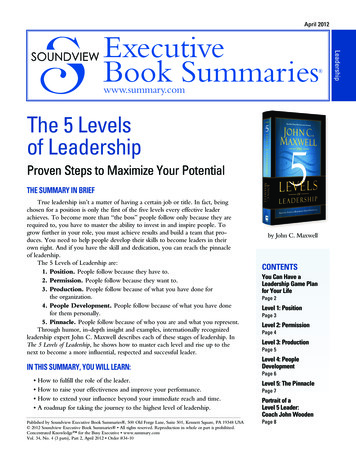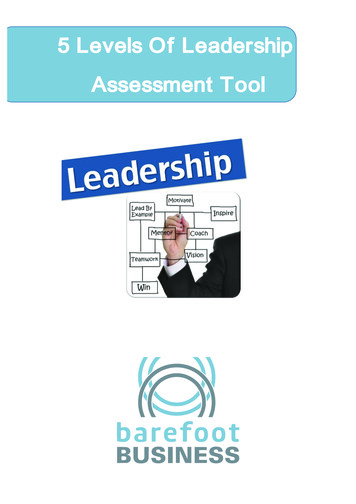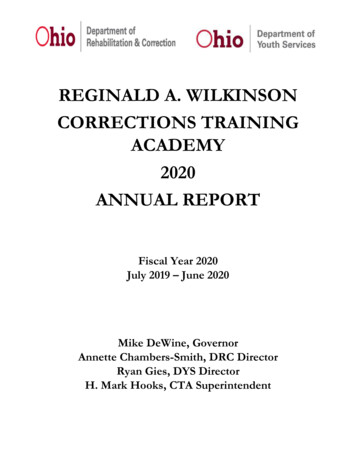
Transcription
April 2012ExecutiveBook Summaries www.summary.comThe 5 Levelsof LeadershipProven Steps to Maximize Your PotentialTHE SUMMARY IN BRIEFTrue leadership isn’t a matter of having a certain job or title. In fact, beingchosen for a position is only the first of the five levels every effective leaderachieves. To become more than “the boss” people follow only because they arerequired to, you have to master the ability to invest in and inspire people. Togrow further in your role, you must achieve results and build a team that produces. You need to help people develop their skills to become leaders in theirown right. And if you have the skill and dedication, you can reach the pinnacleof leadership.The 5 Levels of Leadership are:1. Position. People follow because they have to.2. Permission. People follow because they want to.3. Production. People follow because of what you have done forthe organization.4. People Development. People follow because of what you have donefor them personally.5. Pinnacle. People follow because of who you are and what you represent.Through humor, in-depth insight and examples, internationally recognizedleadership expert John C. Maxwell describes each of these stages of leadership. InThe 5 Levels of Leadership, he shows how to master each level and rise up to thenext to become a more influential, respected and successful leader.IN THIS SUMMARY, YOU WILL LEARN:by John C. MaxwellCONTENTSYou Can Have aLeadership Game Planfor Your LifePage 2Level 1: PositionPage 3Level 2: PermissionPage 4Level 3: ProductionPage 5Level 4: PeopleDevelopmentPage 6 How to fulfill the role of the leader.How to raise your effectiveness and improve your performance.How to extend your influence beyond your immediate reach and time.A roadmap for taking the journey to the highest level of leadership.Published by Soundview Executive Book Summaries , 500 Old Forge Lane, Suite 501, Kennett Square, PA 19348 USA 2012 Soundview Executive Book Summaries All rights reserved. Reproduction in whole or part is prohibited.Concentrated Knowledge for the Busy Executive www.summary.comVol. 34, No. 4 (3 parts), Part 2, April 2012 Order #34-10Level 5: The PinnaclePage 7Portrait of aLevel 5 Leader:Coach John WoodenPage 8LeadershipSOUNDVIEW
THE COMPLETE SUMMARY: THE 5 LEVELS OF LEADERSHIPby John C. MaxwellThe author: John C. Maxwell is an internationally respected leadership expert, speaker and author who has sold more than20 million books. Maxwell is the founder of EQUIP, a nonprofit organization that has trained more than 5 million leaders in126 countries worldwide. Maxwell has written three books that have sold more than a million copies: The 21 Irrefutable Laws ofLeadership, Developing the Leader Within You and The 21 Indispensable Qualities of a Leader.The 5 Levels of Leadership: Proven Steps to Maximize Your Potential by John C. Maxwell. Copyright 2011 by John C.Maxwell. Summarized by permission of the publisher, Center Street, a division of Hachette Book Group, Inc. 289 pages, 25.99.ISBN: 978-1-59995-365-6. To purchase this book, go to www.amazon.com or www.bn.com.Summary copyright 2012 by Soundview Executive Book Summaries www.summary.com, 1-800-SUMMARY.For additional information on the author, go to www.summary.com or JohnMaxwellOnLeadership.com.You Can Have a Leadership GamePlan for Your LifeIn all the years that I’ve taught about leadership, therehas been one lecture that I have been asked to givemore often than any other — from West Point toMicrosoft and in countries all around the world. Thatlecture explains how leadership works, and it provides agame plan for learning how to become a leader. It’s“The 5 Levels of Leadership.”You Can Learn Practical Leadership ToolsThe 5 Levels has been used to train leaders in companies of every size and configuration, from small businesses to Fortune 100 companies. It has been used to helpnonprofit organizations understand how to lead volunteers. And it’s been taught in more than 120 countriesaround the world. Every time I talk about it, people askquestions and make observations. Those things havehelped the 5 Levels of Leadership become stronger anddevelop greater depth. The concept is tested andproven. In addition, it offers several other benefits: The 5 Levels of Leadership Provides a ClearPicture of Leadership. How do people get a handleon leadership? For those who are not naturally gifted forit, leadership can be a mystery. For them, leading peopleis like walking down a dark corridor. They have a senseof where they want to go, but they can’t see ahead, andthey don’t know where the problems and pitfalls aregoing to lie. For many people in the academic world,leadership is a theoretical exercise, an equation whosevariables are worthy of research, study and rigorousdebate. In contrast, the 5 Levels of Leadership is visuallystraightforward, so anyone can learn it.1-800-SUMMARY The 5 Levels of Leadership Defines Leading asa Verb, Not a Noun. Leadership is a process, not aposition. Leadership deals with people and their dynamics, which are continually changing. They are never static. The challenge of leadership is to create change andfacilitate growth. Those require movement, which, asyou will soon see, is inherent in moving up from onelevel of leadership to the next. The 5 Levels of Leadership Breaks DownLeading into Understandable Steps. The subject ofleadership can be overwhelming and confusing. Wheredoes leadership start? What should we do first? Whatprocesses should we use? How can we gain influencewith others? How can we develop a productive team?How do we help followers become leaders in their ownright? The 5 Levels of Leadership gives answers to thesequestions using understandable steps. The 5 Levels of Leadership Provides a ClearGame Plan for Leadership Development. Goodleadership isn’t about advancing yourself. It’s aboutadvancing your team. The 5 Levels of Leadership provides clear steps for leadership growth. Lead people welland help members of your team become effective leaders,and a successful career path is almost guaranteed. The 5 Levels of Leadership Aligns LeadershipPractices, Principles and Values. When I developedthe 5 Levels, I conceived of each level as a practice thatcould be used to lead more effectively. As time went byand I used and taught the levels, I realized they were actually principles. Here’s the difference: A practice is anaction that may work in one situation but not necessarilyin another. A principle is an external truth that is as reliable as a physical law. For example, when Solomon said,Published by Soundview Executive Book Summaries (ISSN 0747-2196), 500 Old Forge Lane, Suite 501, Kennett Square,PA 19348 USA, a division of Concentrated Knowledge Corp. Published monthly. Subscriptions starting at 99 per year.service@summary.com Copyright 2012 by Soundview Executive Book Summaries .Available formats: Summaries are available in several digital formats. To subscribe, call us at 1-800-SUMMARY (240-912-7513 outside the United States), or order onlineat www.summary.com. Multiple-subscription discounts and corporate site licenses are also available.Rebecca S. Clement, Publisher; Sarah T. Dayton, Editor in Chief; Andrew Clancy, Senior Editor; Chris Lauer, Contributing Editor; Amanda Langen, Graphic Designer2 Soundview Executive Book Summaries www.summary.com
Summary: THE 5 LEVELS OF LEADERSHIP“A gentle answer turns away every wrath, but a harshword stirs up anger,” he stated a principle that is universaland timeless.Principles are important because they function like amap, allowing us to make wise decisions. If we embrace aprinciple and internalize it, it becomes a part of our values.The 5 Levels influences my leadership life every day. Level 1: PositionLeadership traditionally begins with Position.Someone joins the Army, and he or she becomes arecruit, working to earn the rank of private. A persongets a job, and along with it comes a title or job description: laborer, salesperson, waiter, clerk, accountant,manager. Position is the starting place for every level ofleadership. It is the bottom floor and the foundationupon which leadership must be built. Real influencemust be developed upon that foundation.There was a time when people relied heavily on position to lead, which is no surprise when you considerthat at one time, hereditary leadership positions werehanded down from father to son (and sometimes daughter) within families. Princes became kings and their decisions were law — for good or bad. In most industrialized nations, those days are gone. True, there are stillnations with kings and queens, but even in most ofthose nations, such as England, monarchs rule with thepermission of the people, and the real leaders are usuallyelected. Position gives you a chance, but it usually carries with it very little real power, except in systemswhere the penalties for not following are dire.There’s nothing wrong with having a position of leadership. When a person receives a leadership position, it’susually because someone in authority saw talent andpotential in that person. And with that title and positioncome some rights and a degree of authority to lead others.Position is a good starting place. And like every levelof leadership, it has its upsides and downsides.The Upside of PositionJust as there are positive and negative aspects in everyseason of life, there are both positive and negative aspectsto every level of leadership. If you are new to leadershipand you receive a position, then there are things to celebrate. Here are four of them:1. A Leadership Position Is Usually Given toPeople Because They Have Leadership Potential.Most of the time when people enter a leadership position, they do so because it was granted or appointed bysome other person in authority. That probably seemsobvious. But think about the implications: It usuallymeans that the person in authority believes that the newleader has some degree of potential for leading. That’sgood news. So if you’re new to leadership and you havebeen invited to lead something, then celebrate the factthat someone in authority believes in you.If you have a new leadership position, then welcometo the first step in your leadership journey. You have aseat at the table and have been invited to be part of the“leadership game.” You will have opportunities toexpress your opinion and make decisions.Your initial goal should be to show your leader and yourteam that you deserve the position you have received.2. A Leadership Position Means Authority IsRecognized. When an individual receives a positionand title, some level of authority or power usually comeswith them. Often, in the beginning, that power is verylimited, but that’s OK because most leaders need toprove themselves with little before being given much.As the Infantryman’s Journal (1954) says, “No man is aleader until his appointment is ratified in the minds andthe hearts of his men.”As a new leader, you must use the authority you aregiven wisely, to advance the team and help the peopleyou lead. Do that and your people will begin to giveyou even greater authority. When that happens, yougain leadership, not just a position.3. A Leadership Position Is an Invitation toGrow as a Leader. There should always be a relationship between receiving a leadership position and fulfilling the requirements demanded by it. One of the mainrequirements is personal growth. I learned this early inmy life from my father, who loved to quote, “To whoever much is given, much shall be required.” Hebelieved that each of us had received a lot in life, andwe had a responsibility to learn and grow so that wecould make the most of it.The journey through the 5 Levels of Leadership willonly be successful if you dedicate yourself to continualdevelopment. If you believe that the position makes theleader, you will have a hard time becoming a good leader.4. A Leadership Position Allows PotentialLeaders to Shape and Define Their Leadership.The greatest upside potential for people invited to take aleadership position is that it affords them the opportunityto decide what kind of leader they want to be. Theposition they receive may be defined, but they are not.When you first become a leader, your leadership pageis blank and you get to fill it in any way you want!What kind of leader do you want to be? Don’t justwww.summary.com Soundview Executive Book Summaries 3
Summary: THE 5 LEVELS OF LEADERSHIPbecome reactive and develop a style by default. Reallythink about it. Do you want to be a tyrant or a teambuilder? Do you want to come down on people or liftthem up? Do you want to give orders or ask questions?You can develop whatever style you want as long as it isconsistent with who you are.As you think about the way you will define your leadership, take into consideration what kinds of habits andsystems you will consistently practice. What will you doevery day when you arrive at work? How will you treatpeople? What will be your work ethic? What kind ofexample will you set? Everything is up for grabs. It’s upto you to define it. And the earlier you are on the leadership journey, the greater the potential for gain if youstart developing good habits now.The bottom line is that an invitation to lead people isan invitation to make a difference. Good leadershipchanges individual lives. It forms teams. It builds organizations. It impacts communities. It has the potential toimpact the world. But never forget that position is onlythe starting point. Five Downsides of PositionSince Position is the lowest level of leadership, ithas a great number of negatives. Here are five:1. Having a Leadership Position Is OftenMisleading. Once you have a position or title, people will identify you with it. However, positions andtitles are very misleading. A position always promises more than it can deliver.2. Leaders Who Rely on Position to Lead OftenDevalue People. As a result, departments, teams ororganizations that have positional leaders suffer terrible morale.3. Positional Leaders Feed on Politics. Whenleaders value position over the ability to influenceothers, the environment of the organization usuallybecomes very political. Positional leaders focus oncontrol instead of contribution.4. Positional Leaders Place Rights OverResponsibilities. Inevitably, positional leadersexpect their people to serve them, rather than looking for ways to serve their people. This does nothingto promote teamwork or create a positiveworking environment.5. Positional Leadership Is Often Lonely. If you’reatop the hill alone, you may get lonely. If you haveothers alongside you, it’s hard to be that way.Level 2: PermissionMaking the shift from Position to Permission brings aperson’s first real step into leadership. Why do I say that?Because leadership is influence, nothing more, nothingless. Leaders who rely on their positions to move peoplerarely develop influence with them. If their subordinatesdo what they are asked, it’s usually because they thinkthey have to — to receive their pay, keep their jobs,prevent being reprimanded and so on.In contrast, when a leader learns to function on thePermission level, everything changes. People do morethan merely comply with orders. They actually start tofollow. And they do so because they really want to. Why?Because the leader begins to influence people with relationship, not just position. Building relationships developsa foundation for effectively leading others. It also starts tobreak down organizational silos as people connect acrossthe lines between their job descriptions or departments.The more barriers come down and relationships deepen,the broader the foundation for leading others becomes.When people feel liked, cared for, included, valuedand trusted, they begin to work together with theirleader and each other. And that can change the entireworking environment. The old saying is really true:People go along with leaders they get along with.Moving up to Level 2 is an important development inleadership because that is where followers give theirsupervisors permission to lead them. People change frombeing subordinates to followers for the first time, andthat means there is movement! Remember, leadershipalways means that people are going somewhere. Theyaren’t static. No journey, no leadership.Best Behaviors on Level 2If you find yourself in a place where you need to startworking to win people’s permission on Level 2, whatshould you do? How can you make the most of theopportunity to develop as a relational leader? Dothe following:1. Connect with Yourself Before Trying toConnect with Others. One of the secrets of connecting with people and building relationships is knowingand liking yourself. In my book Winning With People, Icall it the Mirror Principle, which says, “The first personwe must examine is ourselves.” The work in relationship building always has to start with yourself.2. Develop a People-Oriented Leadership Style.Permissional leaders don’t rely on rules to lead people.They don’t depend on systems. And they never try torule with a stick. (Anyone who does needs to know that4 Soundview Executive Book Summaries www.summary.com
Summary: THE 5 LEVELS OF LEADERSHIPevery stick eventually breaks.) Instead, they use a personal touch whenever they deal with people. They listen, learn and then lead. They develop relationships.They have more than an open-door policy — theyknow the door swings both ways. They go through itand get out among their people to connect.3. Practice the Golden Rule. I always teach thegolden rule: “Treat others as you want others to treatyou.” It is a core teaching that can be found in everyculture and religion. It is the simplest, most profoundand most positive guide to living there is. Practicing thegolden rule enables everyone to feel respected.4. Become the Chief Encourager of YourTeam. For many years I have enjoyed the friendship ofthe Cathy family, the leaders of Chick-fil-A. One daywhen I was having dinner with Truett Cathy, the company’s founder, he said, “Do you know how I identifysomeone who needs encouragement? If the person isbreathing they need a pat on the back!”5. Strike a Balance Between Care and Candor. Ibelieve that people can change their attitudes and canimprove their abilities. And because I do, I talk to themabout where they’re coming up short. If you’re a leaderand you want to help people, you need to be willing tohave those tough conversations. Care without candorcreates dysfunctional relationships. Candor without carecreates distant relationships. But care balanced with candor creates developing relationships. Level 3: ProductionThe Production level is where leadership really takesoff and shifts into another gear. Production qualifies andseparates true leaders from people who merely occupyleadership positions. Good leaders always make thingshappen. They get results. They can make a significantimpact on an organization. Not only are they productiveNo One Can Fake Level 3No one can fake Level 3. Either you’re producingfor the organization and adding to its bottom line(whatever that may be), or you’re not. ThomasWatson, the founder of IBM, noted, “The outstanding leaders of every age are those who set up theirown quotas and constantly exceed them.” That is agood description of Level 3 leaders. They are selfmotivated and productive. As a result, they createmomentum and develop an environment of success,which makes the team better and stronger.individually, but they also are able to help the team produce. This ability gives Level 3 leaders confidence, credibility and increased influence.Another benefit of leadership on Level 3 is that itattracts other highly productive people. Producers areattractive to other producers. They respect one another.They enjoy collaborating. They get things done together. That ultimately creates growth for the organization.Leaders can get to Level 1 for an almost endless number of reasons: They show promise; they have connections; they play politics; they have seniority; the organization is desperate. You name it and someone has probably received a leadership position because of it. Leaderswho are naturally good with people or who take painsto learn people skills can move up to Level 2. But somepeople never move up from Level 2 Permission to Level3 Production. Why? They can’t seem to produce results.When that’s the case, it’s usually because they lack theself-discipline, work ethic, organization or skills to beproductive. However, if you desire to go to higher levels of leadership, you simply have to produce. There isno other way around it.The Laws of Leadership at the Production LevelIf you want to use the Laws of Leadership to help yougrow on Level 3, then consider the following: The Law of Respect: People Naturally FollowLeaders Stronger Than Themselves. When you’re working to gain relational credibility on Level 2, the positiveresults are often intangibles, such as morale and trust. Incontrast, the results of good leadership are highly tangible at Level 3. People see better organization, increasedproductivity and higher profitability. The result is thatthey see your strengths and understand what you can do.Your credibility is established. People respect that andthey follow not only because you treat people well, butbecause of what you do for the team and organization. The Law of Magnetism: Who You Are Is WhoYou Attract. When you reach Level 3 and create a highly productive team, you begin to attract other producers.The great thing about this is that it helps you make theproductive team you’ve developed even more productive. Introducing additional highly productive people tothe team raises the bar and makes everyone more productive. And if there are people on the team who won’tor can’t produce, others will be lined up at your doorwilling to take their place. The Law of the Picture: People Do What PeopleSee. Leaders are usually highly visible to the people theylead, especially if they lead by going first. As a result,their actions are always noticed. If you’re a producer,www.summary.com Soundview Executive Book Summaries 5
Summary: THE 5 LEVELS OF LEADERSHIPthat’s a good thing. Nothing motivates people in a positive way more than seeing a positive leadership model.When people see results from their leaders, they knowresults are expected from them. And whenever resultsare an expectation, greater productivity happens. The Law of Victory: Leaders Find a Way for theTeam to Win. The best leaders on Level 3 find ways towin. They always do. They produce! If you are one ofthose people who consistently produces, then everyonewill want to be on your team. That makes leading thatmuch better. The Law of the Big Mo: Momentum Is aLeader’s Best Friend. Level 3 is where momentum kicksin. Good results create momentum. Having momentumgives you greater results. Greater results create evenmore momentum. With momentum, an organizationcan overcome problems, negativism, past issues, pettinessand upcoming obstacles. The Law of Priorities: Leaders Understand ThatActivity Is Not Necessarily Accomplishment. Level 3leaders do the right things the right way at the right timefor the right reasons. They know that an organizationwhere anything goes eventually becomes a companywhere nothing goes. They plan and act accordingly. The Law of Sacrifice: A Leader Must Give Up toGo Up. Radio broadcaster Paul Harvey remarked, “Youcan tell you’re on the road to success; it’s uphill all theway.” You’ll have to give up some privileges andresources to move up. Leaders learn to let go of everything but the essentials as they climb. The Law of Buy-In: People Buy into the Leader,Then the Vision. The buy-in comes from the relationshipsyou have with them and the results you demonstrate infront of them. They want to know you care about themand they want to know you can produce. Level 4: People DevelopmentEffective leaders understand that what got them totheir current level of leadership won’t be enough to getthem to the next one. They understand that if they wantto keep getting better as leaders, they have to be willingto keep growing and changing, and that each move upthe 5 Levels of Leadership requires a paradigm shift anda change in the way a person leads.On Level 3, the emphasis is on personal and corporateproductivity. The ability to create a high-productivityteam, department or organization indicates a higher levelof leadership ability than most others display. But toreach the upper levels of leadership that create eliteorganizations, leaders must transition from producers todevelopers. Why? Because people are any organization’smost appreciable asset.Good leaders on Level 4 invest their time, energy,money and thinking into growing others as leaders. Theylook at every person and try to gauge their potential togrow and lead — regardless of the individual’s title, position, age or experience. Every person is a potential candidate for development. This practice of identifying anddeveloping people compounds the positives of theirorganization because bringing out the best in a person isoften a catalyst for bringing out the best in the team.Developing one person for leadership and success lays thefoundation for developing others for success.Bringing Out the Best in the TeamIn On the Profession of Management Peter Drucker observed:Making the right people decisions is the ultimatemeans of controlling an organization well. Suchdecisions reveal how competent management is,what its values are and whether it takes its jobseriously. No matter how hard managers try tokeep their decisions a secret — and some still tryhard — people decisions cannot be hidden. Theyare eminently visible. Executives who do notmake the effort to get their people decisions rightdo more than risk poor performance. They risklosing their organization’s respect.How does this emphasis on people and people decisions translate into action? Leaders on the PeopleDevelopment level of leadership shift their focus fromthe production achieved by others to the developmentof their potential. And they put only 20 percent of theirfocus on their personal productivity while putting 80percent of it on developing and leading others.This can be a difficult shift for highly productive people who are used to getting their hands dirty, but it’s achange that can revolutionize an organization and give ita much brighter future.Beliefs That Help a Leader Move Up to Level 5If you have managed to move up to Level 4, you areleading at a very high level, higher than 90 percent of allother leaders. But there is still one level higher that maybe within your reach. Fewer than 1 percent of all leadersachieve it. To prepare yourself to attempt that finalclimb and give yourself the best chance of making it tothe top, you must first embrace the following beliefs:1. The Highest Goal of Leadership Is toDevelop Leaders, Not Gain Followers or DoWork. When you help other people become leaders,you change their lives. You change the way they see the6 Soundview Executive Book Summaries www.summary.com
Summary: THE 5 LEVELS OF LEADERSHIPworld. You change their capacity. You increase theirpotential. You change the way they interact with others.If they become good leaders, you help them improvenot only their lives, but also the lives of everyone theytouch. I believe that is how you change the world forthe better.2. To Develop Leaders, You Must Create aLeadership Culture. You will not be able to move upto Level 5 unless you create a leadership culture. JimBlanchard did this at Synovus. In an interview withGeorge Barna, Blanchard said, “I think the most important and difficult thing is to create a culture in the organization where leadership is really important. It’s important for people in the company to realize that this is agrowth-oriented company, and the biggest thing wehave to grow here is you, because it’s you who willmake this company better by your growth. . So Iwould think making a culture aware of the significanceof developing leaders is valuable.”3. Developing Leaders Is a Life Commitment,Not a Job Commitment. Level 4 leaders developpeople. Level 5 leaders consistently develop leaders overa lifetime, and the leaders they raise up also develop leaders. It becomes a lifestyle they practice everywhere and atall times, not a program they implement or a task theyoccasionally practice. Mentoring is a mantle that theywear willingly and they strive to add value to others. Level 5: The PinnacleRare is the leader who reaches Level 5 — the Pinnacle.Not only is leadership at this level a culmination of leading well on the other four levels, but it also requires botha high degree of skill and some amount of natural leadership ability.It takes a lot to be able to develop other leaders so thatthey reach Level 4; that’s what Level 5 leaders do. Theindividuals who reach Level 5 lead so well for so longthat they create a legacy of leadership in the organizationthey serve.Pinnacle leaders stand out from everyone else. Theyare a cut above, and they seem to bring success withthem wherever they go. Leadership at this high level liftsthe entire organization and creates an environment thatbenefits everyone in it, contributing to their success.Level 5 leaders often possess an influence that transcendsthe organization and the industry they work in.Most leaders who reach the Pinnacle do so later intheir careers. But the Pinnacle level is not a resting placefor leaders to stop and view their success. It is a reproducing place from which they make the greatest impactof their lives. That’s why leaders who reach the Pinnacleshould make the most of it while they can.With gratitude and humility, they should lift up asmany leaders as they can, tackle as many great challengesas possible and extend their influence to make a positivedifference beyond their own organization and industry.Guide to Being Your Best at Level 5Use the following guidelines t
leadership expert John C. Maxwell describes each of these stages of leadership. In The 5 Levels of Leadership, he shows how to master each level and rise up to the next to become a more influential, respected and successful leader. INTHISSUMMARY,YOUWILLLEARN: How to fulfill the role of the leader.










